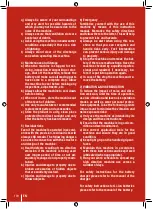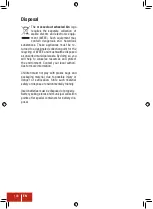
EN
100
q) Always be aware of your surroundings
and stay alert for possible hazards of
which you may not be aware due to the
noise of the machine.
r) Always ensure that ventilation slots are
kept clear of debris.
s) Avoid using the machine in bad weather
conditions. especially if there is a risk
of lightning.
t) Always stand clear of the discharge
zone when operating this machine.
4) Maintenance and Storage
a) When the machine is stopped for ser-
vicing, inspection, transporting or stor-
age, shut off the machine, remove the
battery and make sure all moving parts
have come to a complete stop. Allow
the machine to cool before making any
inspections, adjustments, etc.
b) Always allow the machine to cool down
before storing.
c) When not in use, store the machine out
of the reach of children.
d) Use only manufacturers recommended
replacement parts and accessories.
e) Store the product in a dry, clean place
protected from direct sunlight and only
after the battery has been removed.
5) Residual risks
Even if the machine is operated in accord-
ance with the provision, residual risks will
always still remain. The following dangers
can arise in connection with the structure
and design of the machine:
a) Health defects resulting from vibration
emission if the machine is being used
over longer period of time or not ad-
equately managed and properly main-
tained.
b) Injuries and damage to property due to
broken accessories or hidden objects
that are suddenly dashed.
c) Injuries and damage to property due to
thrown objects.
6) Emergency
Familiarize yourself with the use of this
machine by means of this instruction
manual. Memorize the safety directions
and follow them to the letter. This will help
to prevent risks and hazards:
a) Always be alert when using this ma-
chine so that you can recognize and
handle risks early. Fast intervention
can prevent serious injury and damage
to property.
b) Stop the machine and remove the bat-
tery if there are malfunctions. Have the
machine checked by a qualified profes-
sional and repaired, if necessary, be-
fore it is put into operation again.
c) In case of fire stop the machine and re-
move the battery.
7) VIBRATION & NOISE REDUCTION
To reduce the impact of noise and vibra-
tion emission, limit the time of operation,
use low-vibration and low-noise operation
modes as well as wear personal protec-
tive equipment. Take the following points
into account to minimize the vibration and
noise exposure risks:
a) Only use the machine as intended by its
design and these instructions.
b) Ensure that the machine is in good con-
dition and well maintained.
c) Use correct application tools for the
machine and ensure they are in good
condition.
d) Keep tight grip on the handles/grip sur-
faces.
e) Maintain this machine in accordance
with these instructions and keep it well
lubricated (when appropriate).
f) Plan your work schedule to spread any
high vibration machine use across a
number of days.
For safety instructions for the battery
charger please refer to the manual of the
charger.
For safety instructions for Li-ion batteries
please refer to the manual of the battery.









































